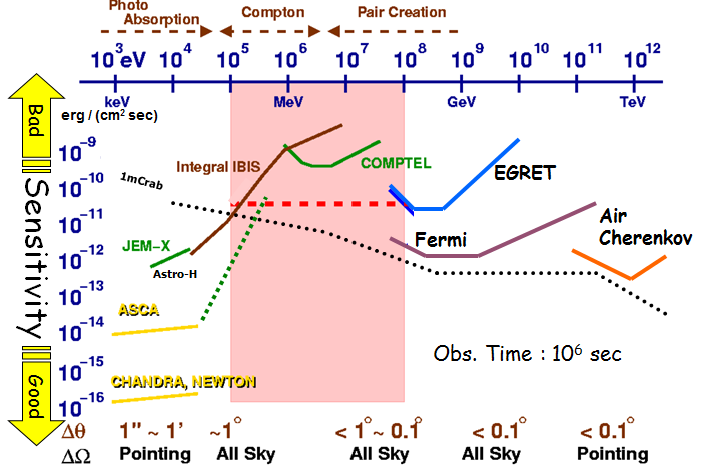MeV gamma-ray astronomy
Nuclear line-gamma
Astrophysical nuclear line-gamma rays are emitted by some radioisotopes or excited nuclei in the universe, which thought to be produced in supernovae.
The observations of line gamma rays expected to solve the mystery of the origin of elements or nucleosynthesis processes.
- Solving the nucleosynthesis process in supernovae utilizing the observations of some line gamma-rays from supernova remnants.
- Measurements of the diffusion of materials in our galaxy, using the distribution of some long-life radioisotopes.
- Limitation to the supernova rate or metalicity with the fluence of line gamma-rays in neighborhood galaxies.
- Survey of dark matter by determination of the positrons origin utilizing the distribution of the electron-positron annihilation line.
Continuum
Almost all of the celestial gamma-ray sources have continuum components.
These continuum spectra provide us the details of the celestial objects by the determination of the radiation processes based on the multi-wavelength spectrum.
- Solving the cosmic-ray origin using the observations of gamma rays emitted from neutral pions produced by the interaction between the cosmic rays and molecular clouds.
- Analysis of the star-formation rate or the amount of gas/halo in galaxies utilizing the observations of gamma rays produced by cosmic rays in galaxies.
- Information around active galactic nuclei by the peak energy of the high-energy photons from active galactic nuclei.
- Knowledge of the high-energy phenomena around neutron stars or black holes.
- Expectation of thermal radiation according to the evaporation of primordial black holes, which was predicted by Stephen Hawking.
Polarization
- Analysis of the magnetic field using the measurements of the polarization angle and polarization degree.
- Solving the explosion mechanism of gamma-ray bursts utilizing the time variation of gamma-ray polarization.
Current state of observations
 As the pioneer of MeV gamma-ray astronomy, COMPTEL(1991-2000) surveyed all sky, it however discovered only ~30 steady gamma-ray sources.
As the pioneer of MeV gamma-ray astronomy, COMPTEL(1991-2000) surveyed all sky, it however discovered only ~30 steady gamma-ray sources.
Because COMPTEL did not realize the designed sensitivity due to the larger amount of background on the orbit than expectation based on the ground calibrations.
In this energy band, there are many kinds of background particles: gamma rays produced by the interactions between cosmic rays and satellite body, atmospheric gamma-rays, atmospheric neutrons, and so on.
Therefore, the observation of the celestial objects in MeV region is very difficult due to the obstruction of such many background particles.
The observations by INTEGRAL (2003-) is ongoing, but the sensitivity in MeV region is still not advanced in comparison with X-ray or GeV/TeV region.
For opening up the window in MeV region, it is necessary to launch a new detector which meets the follow criteria.
- Wide energy range from few hundreds keV to tens MeV
- Large field of view for all sky survey
- Sharp point spread function
- powerful background rejection tools
We are developing such an MeV telescope, and observing the celestial objects using our telescope loaded on balloons.


